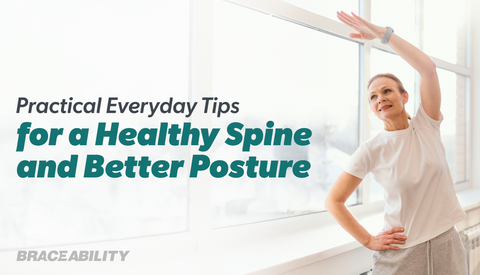De Quervain’s Tenosynovitis Wrist and Thumb Pain
Pain felt in your wrist on the thumb side, can mean a variety of things such as carpal tunnel, trigger thumb, thumb ligament injuries, hand and wrist arthritis, gamekeeper's thumb, or even thumb fractures. A very common reason for thumb pain is de Quervain's tenosynovitis. When this is left untreated, the condition can keep you from enjoying daily activities for some time.
Think you might have de Quervain’s thumb tendonitis? Continue reading to understand the symptoms, causes, and treatments for de Quervain's tenosynovitis, so you can get back to feeling your best!
What is De Quervain's Tenosynovitis?
De Quervain's tenosynovitis, also known as mommy thumb and radial styloid tenosynovitis, is a rather painful condition, affecting the tendons that run from your thumb to the side of your wrist. It is essentially the swelling of the protective covering that wraps around your thumb-sided wrist tendons, called the tendon sheath. The protective covering allows you to turn your wrist, pinch, and grip with your hand. When the tendon sheath swells, it results in pain and restricted movement in your thumb and wrist.

De Quervain Syndrome Symptoms
The most common sign of de Quervain’s is pain and tenderness in your wrist, most often below the base of your thumb. You may also have swelling at the base of your thumb that comes with limited wrist and hand motion when you are trying to grip or pinch something.
If the condition goes untreated for too long, the pain could spread further into your thumb and up your forearm. Continued movements of your thumb and wrist may cause further irritation and pain.
How Do I Know If I Have De Quervain's Tenosynovitis?
Typically, X-rays are not necessary to diagnose de Quervain's tenosynovitis, but your doctor will likely perform a Finkelstein test.
A de Quervain's tenosynovitis test consists of three steps:
- Bend your thumb across the palm of your hand.
- Bend your fingers down over your thumb.
- Bend your wrist toward your pinky finger. If step 3 causes you pain, you most likely have de Quervain’s synovitis.

De Quervain's Tenosynovitis Causes
A variety of activities can irritate your thumb tendon and lead to de Quervain’s tenosynovitis. Conditions such as rheumatoid arthritis (RA) can be a reason for your pain, but overuse of your wrist with repetitive movements are the leading causes of de Quervain’s tenosynovitis.
Activities That Make De Quervain’s Tenosynovitis Worse
Many people have careers that involve activities that are common producers for wrist injury. Those with desk jobs that spend their days typing and scrolling see an increase of de Quervain’s tenosynovitis cases. Construction workers are also at high risk with repetitive movements such as hammering. If you act out these motions right now, you can understand why this happens. Knitting, golfing, playing the piano, and even carrying heavy grocery bags are some other examples of activities that cause or make Quervain’s tenosynovitis worse. Now, you’re most likely not in a position to leave your job, but you can make a conscious effort to be cautious with these activities that may be making your pain worse.

Who Is Most Likely to Have De Quervain’s Tenosynovitis?
This condition occurs most for those between the ages of 30 and 50 years old. Women also tend to be eight to ten times more at risk than men.
Why Is De Quervain’s Tenosynovitis Also Called Mommy Thumb?
If you are pregnant or were previously pregnant and are caring for an infant, you are at an increased risk for developing de Quervain. The repetitive act of lifting and supporting a newborn triggers wrist and thumb pain among many mothers. Men who take over roles as primary caretaker of young infants also have a higher risk of developing tenosynovitis wrist. This is where the terms “mommy thumb” and “mommy wrist” come from. A wrist brace or thumb support can help you get ahead of the pain by providing extra assistance to your thumb that is the leverage of support for your child’s head and body.
De Quervain's Tenosynovitis Treatment
Treatments for de Quervain’s tenosynovitis come with the goal to first reduce pain and swelling, maintain normal joint function, and prevent the pain from returning. Each person is different, so make sure you talk to your doctor about the best plan for you.
6 Things You Should Do To Fix De Quervain’s Tenosynovitis
-
Avoid Painful Activities
It cannot be stressed enough to be aware of the activities you are partaking in that might cause you pain. The more you aggravate the area, the longer it will take to heal and the more intense the pain will become. This goes for daily activities that require you to use your thumb and wrist. Washing dishes, starting your car, or walking your dog could be making matters worse. Bring awareness to these daily tasks and the harm they could be causing.
-
Rest Your Wrist
Like any injury, rest is typically the first recovery tool. Allowing your thumb to rest without added stress or movement is how you will see the most progress. If you are hoping to cure de Quervain’s synovitis quickly, you should take rest very seriously.
-
Apply Ice and Heat
Ice and heat can promote blood flow to injured areas and help with inflammation. For this particular condition, you are most likely experiencing swelling. Because of this, you should start with icing your thumb and wrist for 15-20 minutes several times a day. This can reduce the swelling and promote healing. When the swelling goes down, alternate heat and cold for increased blood flow to the injury for optimal healing.
-
Take Anti-Inflammatory Medication
Non-steroidal, anti-inflammatory drugs are not the solution to your pain, but can certainly assist in reducing swelling and providing you with some pain relief. Please consult with your doctor prior to medication.
-
Physical Therapy
Meeting with a physical therapist can be beneficial for many injuries, but you should be careful with this one. Therapy may not be the best option for everyone with de Quervain tenosynovitis, depending on how bad the condition is. For some, rest just might be the best solution. If your doctor suggests physical therapy, you will likely undergo de Quervain's tenosynovitis exercises. These are typically rather simple wrist tendonitis exercises to bring motion and strength to the affected area.
-
Wear a De Quervain's Tenosynovitis Splint
A great option for prevention and healing wrist pain is by wearing a brace for de Quervain's tenosynovitis. Extra tendon support can be extremely beneficial for relieving stress that creates pain. If you know you are at risk based on your work or the fact that you are a new mother, you can avoid the struggle later by wearing a brace beforehand or during those strenuous activities. We have several options for wrist and thumb supports to choose from!
Do I Need Surgery For De Quervain’s Tenosynovitis
The above treatments are more often than not a success when done right, but in rare cases de Quervain’s tenosynovitis surgery may be necessary. If you go several weeks or months without improvement, surgery may be the next course of action.
Surgery for de Quervain syndrome has a high success rate for relieving the condition. Most people recover with little to no symptoms and without future recurrences. The goal behind surgery is to open the compartment that holds the inflamed tendons (extensor retinaculum) so they can move freely without pain. The procedure is simple and you should be able to return home on the same day.
Recovering from De Quervain’s Tenosynovitis Surgery
Recovering from this procedure can take up to twelve weeks in total before you are painless and able to function freely. Typically, patients will wear a splint full time for the first two weeks before the stitches are removed. By the third week, you should have your stitches out and may be referred to physical therapy for an additional six to eight weeks. For the duration of your recovery, always follow your doctor's direction. They will likely have you follow R.I.C.E. method protocol, meaning you will need to rest your affected hand, utilize ice, apply compression, and elevate your wrist.
Everybody is different, but you should be driving again as soon as you are no longer taking medication prescribed from your doctor. Be cautious in your return to work if your job requires the recovering hand to be used often. Taking time away from work can range from a few days to several weeks. Speak with your healthcare provider to determine the best plan of action for you.












